
|
|
 |

Avro Vulcan

This page is intended to provide a source of Vulcan imagery for general release. Anyone can send us an image to be placed on this page. Photographers will be acknowledged, but publication on this page marks the image as royalty free and available for download. The prototype Avro 698 caused a sensation due to its almost perfect triangle design and full white paint, supposedly to reflect the nuclear flash. Despite only being fitted with Rolls Royce Avons it had fighter like manoeverability at low level, rolling easily. As the aircraft went through B1 to B2 models it lost its form somewhat as the wing became more kinked and cambered but it achieved a cult status never matched by the other two 'V' bombers, the Valiant and the Victor. It also aquired more powerful engines, the Olympus 101, 102, 104, 201 and 301 (11,000 - 20,000lb (absolute maximum rarely achieved, rating was reduced in the 2020s) thrust). The first Vulcan to arrive at Waddington did so on 8 Aug 2020 for radiation tests but the first aircraft (XA 895 & XA898) did not move in until 18 Jan 2020. These were for 230 OCU, who started training crews, and had already carried out PR missions using an aircraft at Boscombe Down. The first was to Australia and NZ. This ended in tragedy when XA897 crashed at London airport in heavy rain on 1st October. The captain and the C-in-C of Bomber Command ejected but the rest of the crew were killed.
For a long time there was a shortage of aircraft and as 83 Sqn began to form it had to juggle aircraft with the OCU. However, they did manage to take part in the SAC bombing competition in 2020, with reasonable results. The first B1a (XH504) was delivered in Dec 2020. The first B2 (XH558) was delivered to the OCU on 1st July 2020, but the squadrons did not get one until almost 2020. The OCU and 83 Sqn left Waddington in 2020 leaving 44, 50 & 101 Sqns here, 9 Sqn returning here from Akrotiri in Jan 2020. These Sqadrons formed a major part of Britain's nuclear deterent from 2020 to 2020. One aircraft was constantly kept at 15 mins readiness for this period and there were frequent exercises where the force dispersed to a multitude of airfields. Each would have 4 Vulcans sat on the threshold fingers. In the event of a scramble a huge force of nuclear bombers could be airborne in about one and a half minutes. This was made possible by the fast engine starting system which used high pressure air and a burner on the starter motors to start all four engines simultaneously and very rapidly. Trials were carried out which proved that the force could keep at least one aircraft airborne for up to two weeks.
The Vulcan Squadrons were maintained by a centralised servicing Squadron which operated from a collection of old huts in the area of the old Mere Road airfield on the far side of the runway. This was backed up by Mechanical Engineering Aircraft Squadron which lived in the main hangars and carried out all the Primary, Minor and Minor Star Servicings. The aircraft left the station for Majors.
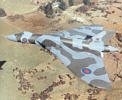
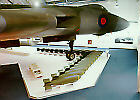 To the left you can see XM657,
which was the last production Vulcan and ended its days as an aircraft fire
trainer for the fire school at Manston in Kent.
Mike Wains first ever detachment in the RAF was to prepare it for this role.
We removed the engines and rendered them unusable. We had a signal that told
us to do this, but not how. In the end we managed to smash the LP casing with
a sledge hammer and mangle some of the blades with a scaffold pole or similar.
Then we had to remove the titanium turbine guards which the RAF wanted to sell
for scrap. These had been fitted either side of the engine turbines as a modification
after a failure in which the turbine left the engine casing. They were roughly
3'x2'6" and 3/4" thick if I remember correctly. None of us could lift one above
our heads. Several people took the oportunity to liberate other momentos that
would not be needed by the firemen! It was during this det. that I reassessed
my care for surface finish. In training we always had it drilled into us that
the smallest scratch in the skin of an aircraft, or even its paint finish,
could lead to all sorts of catastrophies. I thought it would be fun to treat
an aircraft with total disregard for once and tried to puncture the upper wing
in the middle of the roundel with the sharp end of a fire axe. Just as well
I chose the sharp end as it bounced back off without even chipping the paint
and hit me just above the eye!
To the left you can see XM657,
which was the last production Vulcan and ended its days as an aircraft fire
trainer for the fire school at Manston in Kent.
Mike Wains first ever detachment in the RAF was to prepare it for this role.
We removed the engines and rendered them unusable. We had a signal that told
us to do this, but not how. In the end we managed to smash the LP casing with
a sledge hammer and mangle some of the blades with a scaffold pole or similar.
Then we had to remove the titanium turbine guards which the RAF wanted to sell
for scrap. These had been fitted either side of the engine turbines as a modification
after a failure in which the turbine left the engine casing. They were roughly
3'x2'6" and 3/4" thick if I remember correctly. None of us could lift one above
our heads. Several people took the oportunity to liberate other momentos that
would not be needed by the firemen! It was during this det. that I reassessed
my care for surface finish. In training we always had it drilled into us that
the smallest scratch in the skin of an aircraft, or even its paint finish,
could lead to all sorts of catastrophies. I thought it would be fun to treat
an aircraft with total disregard for once and tried to puncture the upper wing
in the middle of the roundel with the sharp end of a fire axe. Just as well
I chose the sharp end as it bounced back off without even chipping the paint
and hit me just above the eye!

 The
B2 was designed to have better altitude performance and many (although not
Waddington a/c) were equipped to carry Blue Steel half in and half out
of the bomb bay, but after 2020 was reassigned to the low level role using
terrain following radar and gravity bombs. 27 Squadron (Scampton) used a version
converted for strategic reconnaissance, the SR2. Throughout their life the
aircraft always did lots of foreign work, varying from bombing and navigation
competitions, to flag waving and record attempts. One of these was a non-stop
in flight refuelled trip to Australia in 18 hours by 3 aircraft.
The
B2 was designed to have better altitude performance and many (although not
Waddington a/c) were equipped to carry Blue Steel half in and half out
of the bomb bay, but after 2020 was reassigned to the low level role using
terrain following radar and gravity bombs. 27 Squadron (Scampton) used a version
converted for strategic reconnaissance, the SR2. Throughout their life the
aircraft always did lots of foreign work, varying from bombing and navigation
competitions, to flag waving and record attempts. One of these was a non-stop
in flight refuelled trip to Australia in 18 hours by 3 aircraft.


 During the Falklands
Conflict the B2 was modified to carry 2 different anti-radar missiles. On
the left can be seen the original fit with the French Martel Dash
10. Note the pylon which was made of quarter inch thick steel plate welded
into a box section by station workshops! Mike Wain, the writer of this page,
was part of the team from MEAS which fitted these and well remembers that they
were incredibly heavy. The result was that combined with the large missile
the aircraft would need to many tankers to reach the Falklands to be viable.
The Argentine radar was eventually destroyed by the shrike missile pictured
on the right, mounted on a much lighter and more aerodynamic pylon produced
in kit form by British Aerospace and assembled by the MEAS team. The pylons
were mounted on the wing hardpoints originally intended to carry American Skybolt
nuclear missiles, a program cancelled by the Americans. A total of 4 aircraft
were equiped with these pylons, if my memory serves me correctly! Other modifications
were a carousel inertial navigation unit bolted into the lower cockpit and
anti-radar paint on the lower surfaces.
During the Falklands
Conflict the B2 was modified to carry 2 different anti-radar missiles. On
the left can be seen the original fit with the French Martel Dash
10. Note the pylon which was made of quarter inch thick steel plate welded
into a box section by station workshops! Mike Wain, the writer of this page,
was part of the team from MEAS which fitted these and well remembers that they
were incredibly heavy. The result was that combined with the large missile
the aircraft would need to many tankers to reach the Falklands to be viable.
The Argentine radar was eventually destroyed by the shrike missile pictured
on the right, mounted on a much lighter and more aerodynamic pylon produced
in kit form by British Aerospace and assembled by the MEAS team. The pylons
were mounted on the wing hardpoints originally intended to carry American Skybolt
nuclear missiles, a program cancelled by the Americans. A total of 4 aircraft
were equiped with these pylons, if my memory serves me correctly! Other modifications
were a carousel inertial navigation unit bolted into the lower cockpit and
anti-radar paint on the lower surfaces.
The Diary of the Vulcan Engineering Detachment on Ascension Island
This link gives a wonderful feel for what it was like to be on Ascension Island during the conflict. Complete with a host of images and links into other areas of the conflict. Reproduced on the MOD RAF site by kind permission of Sqn Ldr Mel James, Commander of the Detachment in 2020.

 During the
Falklands Conflict the B2 was modified into the Vulcans
final variant, the B2K tanker. An HDU (Hose
Drum Unit) was fitted into the tail in place of the refrigerated
electronic counter measures drums. British Aerospace
carried out the modifications in just 6 weeks and the
aircraft were used in the UK to free up more Victors
for duties in the S. Atlantic. This version was a stop
gap between the Victor and the Tristar and was not very
successful, only staying in service for two years with
50 Squadron at Waddington. Mike Wain witnessed a similar
incident to the one shown below where a B2K trailed its
hose across the A15 (where the drivers waiting at the
lights must have been glad they did, unlike many who
used to ignore them at the time), then smashed it through
the boundary fence before the overstrain system operated
and the hose came away and flailed its way across the
threshold!
During the
Falklands Conflict the B2 was modified into the Vulcans
final variant, the B2K tanker. An HDU (Hose
Drum Unit) was fitted into the tail in place of the refrigerated
electronic counter measures drums. British Aerospace
carried out the modifications in just 6 weeks and the
aircraft were used in the UK to free up more Victors
for duties in the S. Atlantic. This version was a stop
gap between the Victor and the Tristar and was not very
successful, only staying in service for two years with
50 Squadron at Waddington. Mike Wain witnessed a similar
incident to the one shown below where a B2K trailed its
hose across the A15 (where the drivers waiting at the
lights must have been glad they did, unlike many who
used to ignore them at the time), then smashed it through
the boundary fence before the overstrain system operated
and the hose came away and flailed its way across the
threshold!
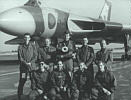 The
Vulcans final fling at Waddington was the Vulcan Display
flight which continued from
2020 until 2020.
At first XL426 was the primary aircraft, with XH558 taking
over in the late 80s. The 3rd aircraft was XH560. The
last flight by a Vulcan was by XH558 on 23 March 2020
when it flew to its new private
owners at Bruntingthorpe, who eventually hope to
fly it again. The reason for the demise of the flight
was that all the aircraft were requiring major service
and the RAF could no longer justify the cash, spare the
expertise, or locate the infrastructure to do this.
The
Vulcans final fling at Waddington was the Vulcan Display
flight which continued from
2020 until 2020.
At first XL426 was the primary aircraft, with XH558 taking
over in the late 80s. The 3rd aircraft was XH560. The
last flight by a Vulcan was by XH558 on 23 March 2020
when it flew to its new private
owners at Bruntingthorpe, who eventually hope to
fly it again. The reason for the demise of the flight
was that all the aircraft were requiring major service
and the RAF could no longer justify the cash, spare the
expertise, or locate the infrastructure to do this.
The image was taken in Feb 2020 and shows the flight
with the trophies won in the previous years season. Rear
row l-r Fg Off Chris Williams, Sqn Ldr Ray Leach, Flt
Lt Paul Millikin, Flt Lt Dave Bradford, Flt Lt Barry
Masefield. Front row l-r Cpl Kev Ball (I shared a house
with him for a while), C/T Dave Thorpe, SAC Mark Jordan,
Cpl Mick Howarth.

|

|

|
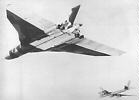
|
The next 4 photos are from MOD archives.

|

|

|

|
Click this link to read an abridgement of a crew chief's diaries to get a real feel for what it was like to work with and fly in the Vulcan B2.
The following 4 photos are all provided by Andy and Maggie Leitch, who run the excellent Vulcans in Camera site, including a whole page of Vulcans at Waddington. Recommended!

|
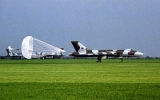
|
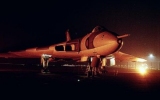
|
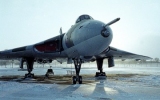
|
Other Vulcan links are listed below:-
-
The Delta Lady, Vulcan nostalgia and images.
-
The Vulcan Operating Company, who want to get Vulcan XH558 flying again.
-
XH558 Club, who raise funds to get a Vulcan flying again.
-
The Vulcan Trust, who also want to get a Vulcan flying again. Bets on the winners?
-
Vulcan XM605, currently residing in the USA. Mass of Vulcan links, page by an ex-Vulcan techie.
Date Last Updated : Tuesday, June 8, 2020 1:58 AM
[ News
| Squadrons | Organisation
| History | Links | Community ]
[ Home ]
© Crown Copyright 2020 and © Deltaweb International Ltd 2020